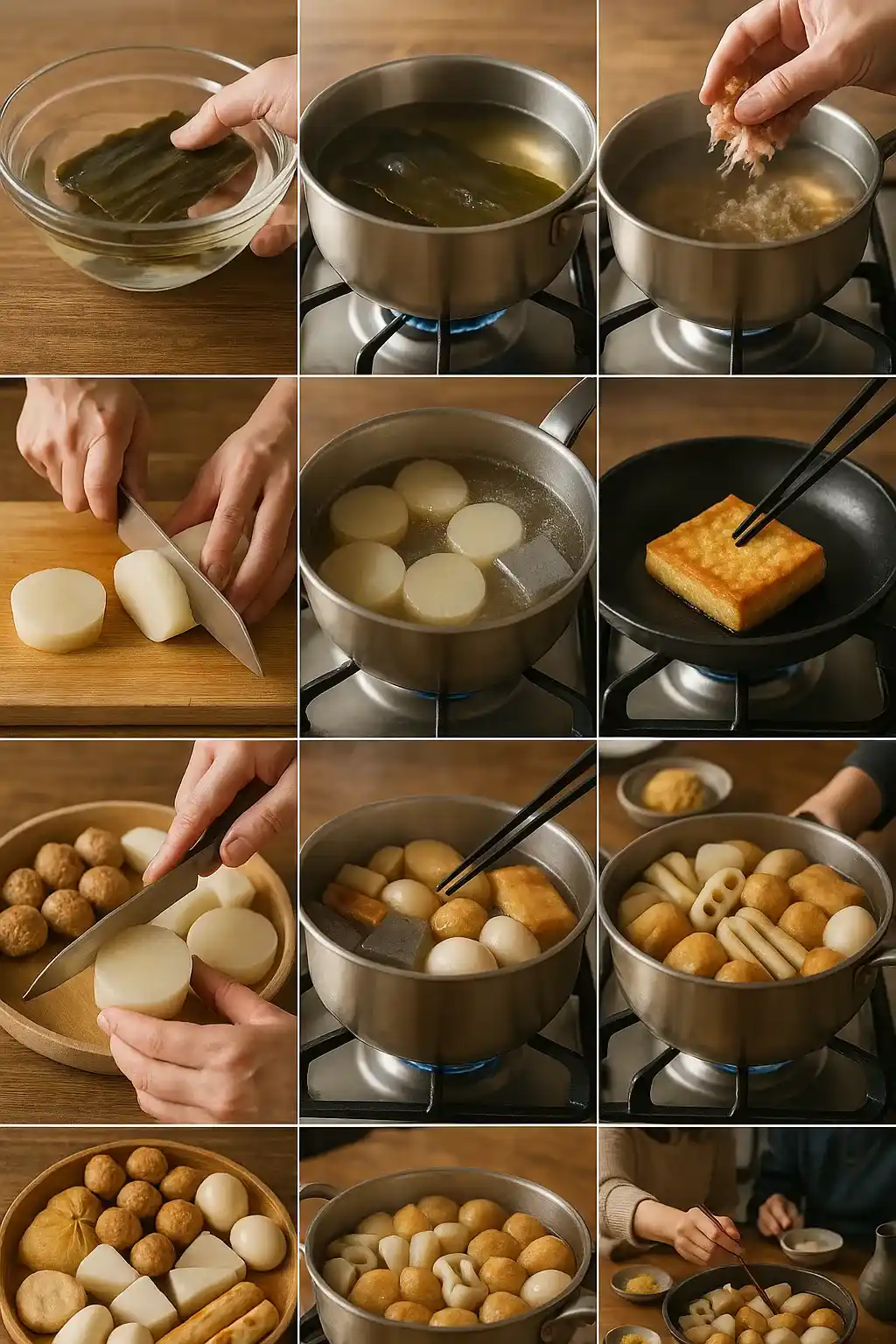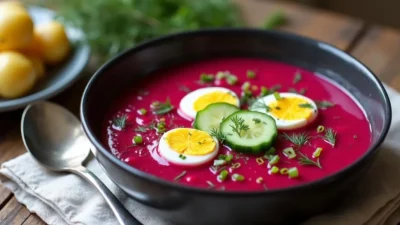Contents
Oden is a traditional Japanese hot pot enjoyed especially during the cold winter months. This simple yet deeply flavorful dish features a variety of ingredients like radish, tofu, fish cakes, and eggs simmered slowly in a delicate broth made from kombu and bonito flakes. Oden is more than just food—it’s a shared experience that brings warmth and comfort to gatherings of family and friends. Easy to prepare at home, oden offers a taste of Japan’s cozy culinary traditions perfect for chilly days.
Ingredients
For the broth:
- 1.5 liters water
- 10 g dried kombu kelp
- 20 g bonito flakes
- 3 tbsp light soy sauce
- 1 tbsp mirin sweet rice wine
- 1 tsp sake or sugar optional
For the oden pot:
- 1 large daikon radish, peeled and cut into thick slices
- 4 hard-boiled eggs, peeled
- 1 block konnyaku (konjac yam cake), cut into pieces
- 4 pieces chikuwa grilled fish cake
- 4 hanpen (soft fish cakes), cut into triangles
- 4 pieces atsuage thick fried tofu
- 4 ganmodoki fried tofu patties
- 4 mochi kinchaku tofu pouches filled with mochi rice cake
- 8 tsukune (chicken meatballs) or store-bought chicken meatballs
Instructions
- Prepare the broth: Soak the kombu in water for about 30 minutes. Slowly heat the water with kombu until just before it boils. Remove kombu before boiling. Add bonito flakes and let steep for 5 minutes, then strain the broth. Return broth to pot, add soy sauce, mirin, and optional sake or sugar. Keep warm on low heat.

- Pre-cook key ingredients: Boil daikon slices in plain water for 10 minutes to soften, then drain. Boil konnyaku briefly for 2-3 minutes, then drain. If tofu pieces are not pre-fried, lightly fry them until golden.
- Simmer ingredients: Add daikon, boiled eggs, konnyaku, fried tofu, and ganmodoki to the broth. Let simmer gently for 30–40 minutes to absorb flavors.
- Add remaining ingredients: Add fish cakes (chikuwa, hanpen), mochi kinchaku, and chicken meatballs. Continue simmering for at least another hour on low heat, stirring occasionally.
- Serve: Serve the pot hot, allowing diners to pick their favorite ingredients. Optionally, provide condiments such as karashi (Japanese mustard), miso paste, or yuzu kosho for dipping. Enjoy with warm sake or tea.
Notes
Oden: a cozy bowl of winter in Japan ❄️🍲
There’s something magical about Japanese winters—and it’s not just the snow. It’s the food. When the weather turns cold, one dish in particular starts popping up everywhere, from tiny food carts to home kitchens: oden. 🥢 Now, if you’ve never heard of it, think of oden as Japan’s answer to comfort food. It’s not flashy or complicated, but that’s part of the charm. Just a big pot of warm broth with all kinds of ingredients slowly cooking together—radish, tofu, fish cakes, boiled eggs... the kind of stuff that makes you feel warm from the inside out. 🔥
What makes oden special?
Honestly? It’s hard to describe oden without actually tasting it. It’s simple—really—but full of flavor. That’s because everything simmers together for hours, soaking up the broth and getting more delicious by the minute. ⏳ And it’s not just about the food. Oden is one of those meals that’s meant to be shared. Friends and family gather around the pot, picking out their favorite pieces, chatting, laughing. It’s the kind of dinner that slows you down—in the best way. 😊👨👩👧👦Let's talk about the broth 🍜
The broth is what ties everything together. It's not heavy or creamy—more like a clear, savory soup with a ton of umami flavor. And the best part? It’s super easy to make. Here’s what goes in:- Kombu (a dried seaweed that adds depth) 🌿
- Bonito flakes (shaved dried fish, packed with umami) 🐟
- Light soy sauce
- Mirin (a sweet rice wine) 🍶
- Optional: a bit of sake or sugar, if you like it richer or sweeter
So, what do you put in it?
Honestly, almost anything. But here are some classics you’ll find in most oden pots:- Daikon – thick slices of radish that go soft and juicy 🥒
- Konnyaku – kind of like a firm jelly, weird at first but super satisfying
- Atsuage – thick tofu that’s been fried a little, so it has this great texture 🍲
- Ganmodoki – tofu mixed with veggies and fried into little patties
- Hanpen – soft, white fish cake that’s super light
- Chikuwa – grilled fish cake that’s chewy and flavorful
- Mochi kinchaku – this one’s fun: a pouch of tofu skin stuffed with gooey mochi rice cake 🍡
- Hard-boiled eggs – classic, simple, and always good 🥚
- Tsukune – soft chicken meatballs that soak up everything around them 🍢
How do you eat oden?
You don’t plate it all fancy. Just keep the pot on the table and let everyone pick what they want. A little bit of karashi (Japanese mustard) on the side goes a long way—gives it a spicy kick. Some regions like to dip things in miso, others use yuzu kosho (spicy citrus paste). Play around with it. Also? A warm drink doesn’t hurt. Oden and hot sake are best friends. 🍶✨
Also? A warm drink doesn’t hurt. Oden and hot sake are best friends. 🍶✨




